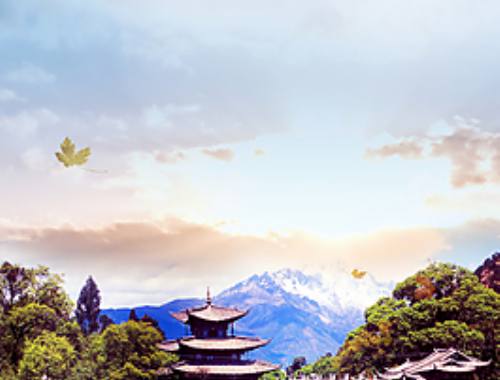
导读
四六级翻译具有十分鲜明的中国特色,具体涵盖三大类,分别是历史文化(以介绍中国历史上的朝代、中国传统节日等为主)、旅游地理(以名山大川、江河湖海的介绍为主)、社会发展(主要介绍当今中国在外交、经贸、科技、环保、民生等领域的发展现状及其成就)。
书法
戏剧
中国传统戏剧连同古希腊悲剧、喜剧和印度梵语戏剧被称为世界三大古代戏剧。中国古代戏种超过 360 种,京剧的历史虽然不足 200 年,但是这个年轻的戏种却成了中华民族戏剧的代表。京剧是一种集音乐、声乐表演、哑剧表演、舞蹈和杂技于一体讲述历史故事或民间传说的中国戏曲。Chinese traditional opera is considered one of the world’s three ancient operas, together with Greek tragedy and comedy, and Indian Sanskrit opera. Among the more than 360 ancient local operas in China, Peking Opera is known as Chinese national opera, despite its comparatively young 200-year history.Peking opera or Beijing opera is a form of Chinese opera which combines music, vocal performance, mime, dance and acrobatics to tell stories from Chinese history and folklore.徽班在 1790 年的时候从安徽带来徽剧为乾隆皇帝庆祝 80 岁生日,此后京剧由此演变创生。京剧最初只在宫廷中演出,随后才为普通市民所接触。Peking opera was born when the “Four Great Anhui Troupes” brought Anhui opera, or what is now called Huiju, in 1790 to Beijing, for the eightieth birthday of the Qianlong Emperor. It was originally staged for the court and only made available to the public later.唱、念、坐、打是京剧的四种表演形式也是京剧的四项基本技能。Singing, recitation, acting, and acrobatic fighting are the four artistic means and the four basic skills of Peking opera.京剧人物通常按照性别、年龄、性格、职业和社会地位进行分类。现代京剧主要有四种角色:生(男性)、旦(女性)、净(画花脸的男性)、丑(小丑)。The characters of Peking opera are classified according to sex, age,disposition, profession, and social status. There are four major roles in Peking opera in modern time: Sheng (male), Dan (female), Jing (male with a painted face) and Chou (clown).脸谱是运用色彩和线条构成各种图案,以象征人物的性格和品质。脸谱的作用可归纳成四点:暗示性格、介绍特点、褒贬善恶、明辨美丑。Facial makeup indicates that colors and lines are used to form various patterns to symbolize the personality and morality of the characters. The function of facial makeup can be summarized into four points: suggesting personality, introducing features, praising virtue or punishing vice and identifying beauty and ugliness.京剧除了在中国大陆生存和发展以外,还传播到许多其他地方。在香港、台湾以及海外华人社区中都能找到京剧的身影。 In addition to its presence in China’s mainland, Peking opera has spread to many other places. It can be found in Hong Kong, Taiwan, and overseas Chinese communities elsewhere.
【备考】四六级翻译预测:文化艺术类---书法、国画、京剧、昆曲、黄梅戏、秧歌舞、相声、杂技
【翻译素材】中国范儿:京剧脸谱
【趣读】用英语唱京剧听过吗?
武术
“武术”字面意思就是“搏斗的艺术”。这个词由两个字组成,“武”是“搏斗的”“军事的”,而“术”可理解为“艺术”、“规则”或“技巧”。“拳法”是中国武术的另一个术语,它指的是“用拳的方法”或“行拳的规则”。“Martial art” is literally formed from the two Chinese characters 武 and 术 : 武 , meaning “martial” or “military” and 术 which translates into “art”,“discipline”, “skill” or “method”. Quanfa is another Chinese term for Chinese martial arts. It means “fist method” or “the law of the fist”. Although as a compound term it usually translates as “boxing” or “fighting technique”.有神话传说是这样描述的,在半神话时期的夏朝,黄帝最早在中国推行武术。他在成为君主以前是一位著名的将领并写下了许多关于医学、占卜术和武术的著作。而他的主要对手蚩尤是角抵术的发明者,蚩尤被誉为现代中国武术的先驱。According to legend, Chinese martial arts originated during the semi-mythical Xia Dynasty more than 4,000 years ago. It is said the Yellow Emperor introduced the earliest fighting systems to China. The Yellow Emperor is described as a famous general who, before becoming China’s leader, wrote lengthy treatises on medicine, astrology and the martial arts. One of his main opponents was Chiyou who was credited as the creator of Jiaodi, a forerunner to the modern art of China.中国武术有悠久的历史渊源,有数百种拳法。过去两千年,许多独具特色的拳法在技巧和思想上都得到了发展。中国武术可以按照用“气”来进行分类,注重运气的拳叫内家拳,那些注重肌肉训练和血管保健的拳叫外家拳。也可以按照地域来归类,分为北拳和南拳。China has a long history of martial arts traditions. Martial arts have hundreds of different styles. Over the past two thousand years, many distinctive styles have been developed, each with its own set oftechniques and ideas. Chinese martial arts can be split into external and internal according to the manipulation of “qi”. Some styles focus on the harnessing of qi and are labeled internal, while others concentrate on improving muscle and cardiovascular fitness and are labeled external. Chinese martial arts can also be categorized by location, as in northern and southern as well, referring to what part of China the styles originated from.
中医
中医是具有 2500 多年历史的传统医学。中医涵盖多种形式,包括中药、针灸、推拿、拔罐、气功、食疗和刮痧。中医的四诊:望、闻、问、切是诊断疾病的四个基本步骤,也是疾病正确归类和治疗的前提。Traditional Chinese medicine is a style of traditional medicine based on more than 2,500 years of Chinese medical practice that includes various forms of Chinese herb medicine, acupuncture, Chinese medical massage, cupping, qigong, food therapy, and skin scraping. The four diagnostic methods of Chinese medicine, namely inspection, auscultation and olfaction, inquiry, pulse taking and palpation, are the four basic procedures used in diagnosing a disease. They are the presuppositions of correct differentiation and effective treatment in traditional Chinese medicine.中药是中医治疗的核心部分。不同的中药成分都有独特的功效,互相协调帮助人体保持健康,具有提气和保持阴阳平衡的作用。Chinese herb medicine is a vital part of Chinese healing. Each ingredient has unique characteristics. The ingredients work in harmony to help a person’s body. Herbs can help boost “qi” and balance Yin and Yang.针灸是用细针刺激人体穴位。与你想象恰好相反的是,病人在针灸时通常极少感觉到疼痛或者几乎感觉不到疼痛。针灸用的银针像头发丝那么细,常常是用手扎或者用电刺激。这些针都必须扎在阴阳经络点上。Acupuncture involves the stimulation of anatomical points on the body with thin needles. Contrary to what you might think, acupuncture patients usually feel from little to no pain. Acupuncture needles are hair-thin and are manipulated either by hand or electricity. Needles are placed at “Yin/Yang Meridian points”艾灸是用艾蒿进行治疗的传统疗法。艾蒿长成以后会分化出艾绒,将艾绒进一步加工成类似于雪茄的棒状,点燃艾条,用燃烧的热量加热身体或者针灸部位。Moxibustion is a traditional therapy by using moxa ( 艾 蒿 ) or mugwort. Mugwort is aged and grouped up to a fluff. Then the fluff is furtherprocessed into a stick that resembles a cigar and it is used to warm areas of the body and acupuncture points.拔罐疗法是中医非药物治疗的重要组成部分,已有数千年的历史。通过拔和按的机械操作,在负压的作用下,这种疗法可以疏通经络,促进血液循环,去除血淤,解毒输氧。它被认为在全身性疾病、呼吸系统疾病、循环系统疾病、消化系统疾病等疾病的治疗方面具有显著功效。Cupping therapy is an important part of non-drug therapy in traditional Chinese medicine, with a history of thousands of years. Under the action of negative pressure, this therapy dredges meridians, promotes blood circulation, removes blood stasis, detoxifies and oxygenates by mechanical effects of dragging and pressing. It is thought to have the ability tooffersignificant effects on systemic disease, respiratory system disease, circulation system disease, digestive system disease, and others.推拿也是一种治疗手段,推拿师用手接触患者体表,在患者受伤部位运用推、握、按、搓、揉、点击和拍打等一系列技术手段让患者疏通经络、减轻疼痛。Chinese medical message is a treatment method, by which the physician apply his hands to the body surface, in proximity to the patients’ injuries using multiple techniques (pushing, holding, pressing, friction, rubbing, kneading, dotting and patting, in order to “dredge meridians” and relieve pain.刮痧疗法是以经络和穴位理论为指导,使用特殊的器具和方法在人体表面一次次刮擦。这种疗法可以调节肌肉的张弛,从而调节软组织压力,改善血液流动。该方法具有治愈的理论和实践基础。Scraping therapy is guided by the theory of meridians and acu-points, and in so-doing scrapes and rubs the body surface again and again using special instruments and methods. This therapy can adjust the contraction and tension of muscle, which may adjust the pressure between tissues and improve blood flow. This method has both practical and theoretical foundations for healing.气功可以调节呼吸、沉淀思想,提升体内气的流动。气功可以用来治病。外气功指的是气功大师作用于某个人身上的功力,而内气功是一个人独自修炼的功法。Qigong regulates the mind and breathing to promote the flow of Qi. Qigong is often used to treat diseases. External Qigong is performed on a person by a Qigong master, while Internal Qigong is practiced by oneself.
【备考】四六级翻译素材---中医
▌信息: 大学云英语综合整理编辑,转载请注明出处!
▌配图:来自网络,仅用于学习交流与研究。如有侵权,请联系我们删除
▌编辑:大学云英语
【CET】 滴滴滴!重大消息!上半年四六级出分时间定了!
【科普】一篇文章帮你读懂四六级笔试! 【CET】四六级翻译攻略(附实例分析) 【翻译资料】中国传统文化关键词:四书五经之《论语》 2017年6月大学英语六级真题答案------翻译 2017年12月六级翻译答案 【四六级】2020年7月英语四级参考答案(翻译) 【四六级】2020年7月英语六级参考答案(翻译) 【CET 6】2019年6月大学英语六级真题翻译
【CET 6】2018年12月大学英语六级真题翻译
【CET】翻译---四大名著 【CET】翻译---四合院 【备考】四六级翻译高分攻略 【CET】翻译---红楼梦 【CET】翻译---西游记
【CET】翻译预测---人工智能
【CET】翻译预测---丝绸之路
【CET】翻译预测---一带一路
【CET】翻译预测---5G
【CET】翻译预测---水稻
【CET】辟谣:《全国高校四六级平均分排行榜Top200!》不靠谱!!!
@所有人|2021年6月四六级将于3月份开始报名!附备考规划!
【CET】四六级备考高分规划
【备考】四六级写作提分技巧
【演讲】“清华刘昊然” 在‘21世纪杯’总决赛演讲
【备考】四六级高频同义替换词(七)
【词汇】常见英语熟词生义!

